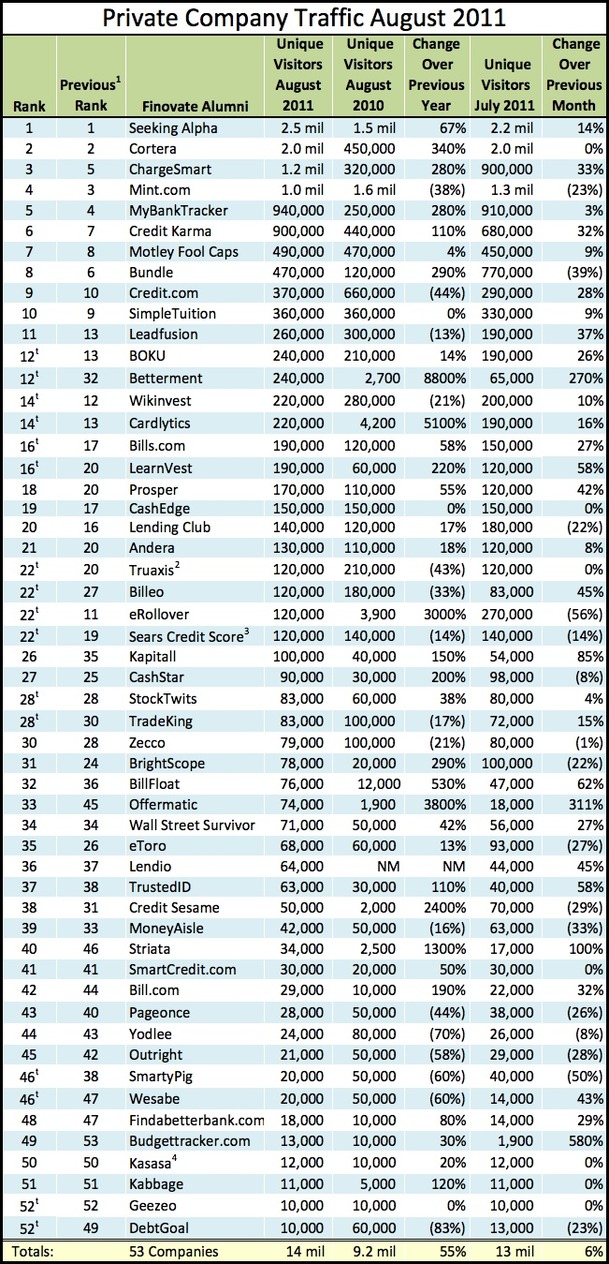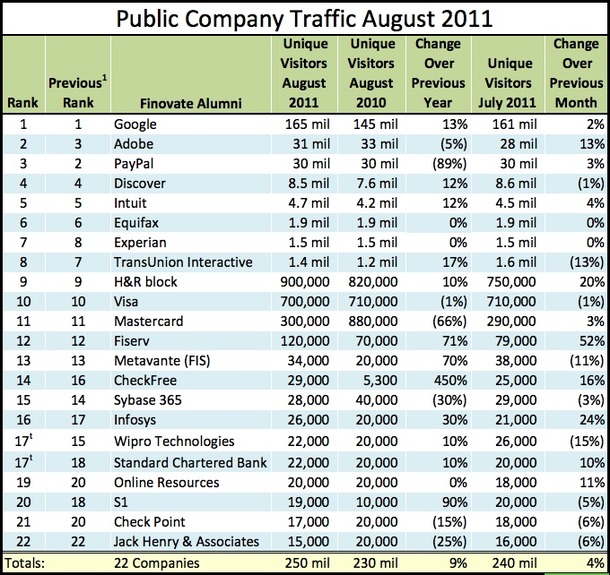- “Record September originations of $7.4 mil, up almost four-fold from $2.0 mil last year
- 11% compounded monthly growth rate over the last 12 months
- Currently, providing a 10.7% “seasoned return” to investors
- Actual annualized loss rate of 5.5%, beating forecast loss rate of 7.1%
- High credit-quality consumer loans: 737 average Experian Scorex PLUS credit score for first-time Prosper borrowers.”
Finovate Alumni News, October 21, 2011
 After being acquired by Taulia, billFLO announces its services will be shutting down Dec 1, 2011.
After being acquired by Taulia, billFLO announces its services will be shutting down Dec 1, 2011.
- Fox Business News mentions ChargeSmart’s mortgage payment solution.
- DoughMain explains how to ease children’s financial fears.
- Business Insider uses BillFloat and Prosper.com as examples of alternative financing companies.
- Dwolla now integrated with Active Merchant for use in Shopify.
- Weemba seeks to help with cash-flow issues during the holiday season.
- Prosper’s September volume is four times larger than 2010.
Finovate Alumni Website Traffic in August
- Seeking Alpha — the most-trafficked in August with 2.5 million unique visitors — also had the highest increase in number of unique month-over-month visits with 300,000 more visits in August than in July.
- Budgettracker.com saw the highest monthly growth percentage with more than 6.5 times the number of unique visitors in August compared to July.
- Betterment had the highest percentage growth year-over-year, up 88x.
- Cortera had the highest number of unique year-over-year visitors, growing by 1.5 million.
ING Direct Read-Only Access Code for Third-Party PFMs
 To my knowledge, ING Direct is the only major U.S. bank blocking third-party PFM access. But users can direct their PFM around the gate with a special "read-only" access code.
To my knowledge, ING Direct is the only major U.S. bank blocking third-party PFM access. But users can direct their PFM around the gate with a special "read-only" access code.
How it works
It’s not particularly easy to find, buried three levels deep in MyAccounts | Preferences | Access Code.
The default setting is Blocked, as you can see in the first screenshot below.
But once you find the page, it couldn’t be simpler to set up. Simply press the blue Create Access Code button in the upper right, and in a split second, you have created a read-only access code and opened your account to PFM access.
To change back, you merely click the "Block" button in upper right.
The only thing missing is an explanation of what to do with the Access Code. Is it the username or password? While that’s explained in an link from the first page, it’s not on the second page where you need it. (BTW, it’s the password).
The bank also confirmed the new code via email right away (third screenshot).
—————————————————–
Access code main page (20 Oct 2011)
New access code
Email confirmation
———————————-
Note: OBR subscribers can access our previous reports on security at OnlineBankingReport.com (published in 1999, 2003, 2004, 2005, 2007 and 2008).
Finovate Alumni News– October 20, 2011

- FreeMoneyWisdom blog interviews Jon Stein, Betterment CEO.
- Silicon India Startup blog lists Expensify as a good app for busy CEOs.
- National Review Online holds BankSimple up to Richard Bronson’s new ethics initiative.
- Bremer Bank to add CheckFree RXP from Fiserv.
- Yaron Samid of BillGuard & Jon Stein of Betterment to show how their products help solve #occupywallstreet issues.
- Check out Finovate Alumni Website Traffic in August.
- mFoundry & SecondMarket Hit Deloitte’s 2011 Technology Fast 500 list.
mFoundry & SecondMarket Hit Deloitte’s 2011 Technology Fast 500 List
Design: Financial Websites that Work on PC Monitors, Laptops, Tablets and Smartphones
 The browser was supposed to make web design simple, at least in terms of page layout. But it’s always been tough to keep up with changing screen sizes, varying resolutions, and frustrating differences between browsers.
The browser was supposed to make web design simple, at least in terms of page layout. But it’s always been tough to keep up with changing screen sizes, varying resolutions, and frustrating differences between browsers.
Liquid layouts that adjust automatically to the available screen real estate have been a huge help. But then along came the mobile browser, complicating everything both by their small size and by the two viewing modes, portrait and landscape.
But it’s not an insurmountable problem. Square is one financial company that’s doing it right. It’s website looks just as good on a 10-inch iPad2 screen as it does on a 24-inch monitor (see screenshot #1 to 4 below).
To make it work, copy and navigation options must be kept to a bare minimum. Square uses a catchy background image of its reader in use, then has an info box that "floats" depending on the screen size. It even works in portrait mode on the iPad (screenshot #4).
Of course, it’s much easier to pull off for a one-product company like Square than for a commercial bank with dozens of business lines.
But even Square had to make compromises on its smartphone layout (see inset above). Instead of asking for contact info, the company simply instructs users to download one or both of its apps: Square or Card Case.
Relevance for Netbankers: We are about to see a flood of redesigned websites using new design and programming techniques (e.g. HTML5). Citibank was the first major U.S. bank to simplify its design. Discover just emailed users today with a sneak preview of its pared down design (screenshot #6). And it already had a relatively clean design (screenshot #5).
—————————-
1. Square homepage on 24-inch monitor
2. Square on 12-inch laptop
3. Square iPad landscape
4. Square iPad portrait
5. Discover homepage (current)
6. Discover new (coming soon)
————————————–
Note: We cover financial website and mobile design issues periodically in our Online Banking Report (subscription).
BillGuard Receives $10 Million in Series B Funding
 Yesterday, TechCrunch covered BillGuard’s new round of funding:
Yesterday, TechCrunch covered BillGuard’s new round of funding:
“Khosla led the round, a $10 million series B. Other investors include Founders Fund, Eric Schmidt’s Innovation Endeavors, Bessemer, IA Ventures, Saul Klein, and Joe Lonsdale. The startup raised a $3 million series A in February, 2011.”
Finovate Alumni News– October 19, 2011
 MyBankTracker.com covers the FinovateFall Best of Show videos.
MyBankTracker.com covers the FinovateFall Best of Show videos.
- American Banker discusses the effects that PayPal and BankSimple will have on bank branches.
- InComm named Leading Prepaid Organization and Best Prepaid Product Distributor at 2011 Prepaid Awards.
- Dynamics wins Best of Show at 2011 BAI Retail Delivery Conference for its next-gen magnetic stripes.
- Des Moines Register reports that Ben Milne, Dwolla CEO is to present at the Thinc Iowa event.
- T8 Webware to provide Call FCU with a custom website.
- A+FCU launches BillShrink: Statement Reward.
- Prosper provides even better rate discounts for repeat Prosper borrowers.
- BillGuard receives $10 Million in Series B funding.
FinovateFall 2011 Demo Videos Now Available
![]() Last month in Manhattan, 63 leading fintech companies showed off their latest innovations to a packed house at FinovateFall 2011. The audience was our largest ever with over 1,000 bankers, analysts, VCs, bloggers, press and entrepreneurs in attendance.
Last month in Manhattan, 63 leading fintech companies showed off their latest innovations to a packed house at FinovateFall 2011. The audience was our largest ever with over 1,000 bankers, analysts, VCs, bloggers, press and entrepreneurs in attendance.
As usual, we’ve put the videos of all the demos live in the archives for free so you can watch at your convenience and share them with others. We hope you enjoy the videos and that you’ll consider joining us in person at our next conference, FinovateEurope 2012 (February 7th in London)!
FinovateFall 2011 was sponsored by: The Bancorp, Tier One Partners, TxVia, and the law firm of CB&S.
FinovateFall 2011 was partners with: BankInnovation.net, BankerStuff, Celent, CardWeb, deutsche-startups.de, Filene Research Institute, Finance on Windows, PYMNTS.com, Mercator Advisory Group, MyBankTracker.com & Mobile-Financial.com.
Finovate Alumni News– October 18, 2011
 TSYS signs payments agreement with Imperial Bank.
TSYS signs payments agreement with Imperial Bank.
- The Baltimore Sun mentions BillFloat & Prosper.com as two companies that are assisting cash-strapped consumers.
- LearnVest launches LV Mom’s Newsletter & 2 new products: Baby On Board Bootcamp & LV Discussions.
- Weemba gives small businesses simple, direct pipeline for raising financing pre-holiday season.
- Morningstar recommends CheckFree to help control your bills by setting up automatic payments.
- Continuity Control buys Compliance Services Group of Iowa & Kirschler Peterson & Associates of Atlanta.
- Crain’s New York Business.com mentions BillGuard, BankSimple, Betterment, SecondMarket, On Deck Captial & Plastyc.
- Jemstep launches out of beta to offer custom investment advice & guidance.
Jemstep Launches Out of Beta to Offer Custom Investment Advice & Guidance
 Jemstep launched an investment guidance and management service to the public today. The purpose of the free service is to help investors better control their financial future:
Jemstep launched an investment guidance and management service to the public today. The purpose of the free service is to help investors better control their financial future:
“Three years in development, the company’s patented investment evaluation technology analyzes more than 20,000 mutual funds and exchange-traded funds (ETFs) to identify the best investment options based on each investor’s unique goals and preferences. Data-driven, unbiased and transparent, Jemstep’s recommendations enable investors to decide what to buy, what to sell and what to keep.”
Jemstep CEO Michael Blumenthal describes the new service as personalized, objective, and actionable.
To learn more about Jemstep, watch its FinovateSpring 2010 demo.














